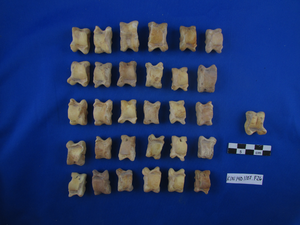Paleozoology
Animal bones are some of the most numerous finds recovered from most archaeological sites, and Kınık Höyük is no exception. Faunal remains can provide important information on past animal husbandry practices, hunting patterns, and diets. The large faunal samples that have been recovered from the first three seasons at Kınık Höyük can shed light on the way animals were used during the Iron Age, the Hellenistic Period, and the Middle Ages at Kınık.
 Doug Campana and I joined the Kınık Höyük team in 2013. During the 2013 field season, we identified and recorded all the animal bones that had been excavated during the 2011 and 2012 field seasons. Our study of the bones begins with basic identification of the animal bones and fragments. We examine each bone fragment to determine the part of the body that it comes from and the species it represents. We also examine the bones for any traces of cut marks or gnawing. Bone measurements allow us to estimate the size of these ancient and medieval animals, and we also try to determine the sex of the animals and the ages at which they died. We record all our observations on our laptop PC, using a specialized database called FAUNA that was designed by Doug Campana.
Doug Campana and I joined the Kınık Höyük team in 2013. During the 2013 field season, we identified and recorded all the animal bones that had been excavated during the 2011 and 2012 field seasons. Our study of the bones begins with basic identification of the animal bones and fragments. We examine each bone fragment to determine the part of the body that it comes from and the species it represents. We also examine the bones for any traces of cut marks or gnawing. Bone measurements allow us to estimate the size of these ancient and medieval animals, and we also try to determine the sex of the animals and the ages at which they died. We record all our observations on our laptop PC, using a specialized database called FAUNA that was designed by Doug Campana.
Most of the fauna we identified from the 2011 and 2012 seasons came from the medieval features. The medieval assemblage was dominated by the remains of sheep and goats, followed by cattle. There were almost no pigs in the medieval assemblage, indicating that these remains were probably associated with the 12th-13th-century Seljuk Turkish population. The medieval features also produced the remains of a number of non-food animals, including horses, donkeys, camels, and dogs. Small numbers of hunted animals included the remains of deer, foxes and hares. The Seljuk Turks kept chickens, and small numbers of goose and duck bones were also identified. They supplemented their diet by hunting cranes and partridges. We also recovered the remains of several turtles, which do not seem to have been part of the medieval diet; they appear to have died in and around the site.
Smaller faunal assemblages were recovered from the Late Iron Age and Hellenistic features. These assemblages are also dominated by the remains of sheep, goats, and cattle, but the Late Iron Age assemblage also included quite a few pig bones.
Our 2013 work at Kınık Höyük was supported by a grant to Lorenzo d'Alfonso and Pam Crabtree from the New York University Research Challenge Fund (URCF). Crabtree recently received a grant from the American Research Institute in Turkey (ARIT) that will allow her to continue her research at Kınık Höyük this summer. She and Doug Campana plan to focus their research on the Achaemenid (6th-4th century BCE) faunal assemblage that was recovered during the 2013 excavation season. This rich faunal assemblage was associated with bird figurines and quantities of ash, and it may represent some form of ritual behavior—possibly ritual feasting. We also plan to work closely with our Turkish colleagues who are excavating the site of Tepecik-Çiftlik, an Aceramic Neolithic, Pottery Neolithic, and Chalcolithic site. When the results of the two sites are combined we will be able to trace the history of animal husbandry and hunting in the region from the beginnings of the Neolithic Period through the later Middle Ages.
Publications
Pam Crabtree, in press. Chalcolithic Animal Bones from Tepecik: Faunal Remains Recovered from the 2013 Season. In Melendiz Project and Tepecik-Çiftlik Excavation: Preliminary Outcomes and Ongoing Researches, edited by A. M. Bükükarakaya, Y. G. Çakan, and M. Godon.
Pam J. Crabtree, Douglas V. Campana, Andrea Trameri, Nancy Highcock, and Lorenzo d'Alfonso, in press. Subsistence and Ritual: A Note on the Achaemenid Faunal Remains from the Site of Kinik Höyük, Southern Cappadocia, Turkey. In Proceedings of the 12th meeting of the Archaeozoology of Southwest Asia and Adjacent Areas, edited by C. Cakirlar et al. Groningen: Groningen Archaeology Series
Pam J. Crabtree and Douglas V. Campana, 2016. Animal Bone Remains from the site of Kinik Höyük, Southern Cappadocia, Turkey: Animal husbandry and hunting practices during the Iron Age, Hellenistic, and Medieval periods. Proceedings of the 9th International Congress on the Archaeology of the Ancient Near East, Basel, edited by R. A. Stucky, O. Kaelin, and H.-P. Mathys, pp. 689-695. Wiesbaden: Harrassowitz Verlag.
Nancy Highcock, Pam Crabtree, Douglas V. Campana, Marco Capardoni, Anna Lanaro, Alvise Matessi, Naomi Miller, Philip Strosdahl, Andrea Trameri and Lorenzo d'Alfonso, 2015. Kınık Höyük, Niğde. A New Archaeological Project in Southern Cappadocia. In The Archaeology of Anatolia: Recent Discoveries (2011-14) Volume I, edited by Sharon Steadman and Gregory McMahon, pp. 98-127. Newcastle: Cambridge Scholars Press.
Pam Crabtree, 2014. ARIT Fellowship Report—Subsistence and Ritual: Analysis of the Animal Bone Remains from the Achaemenid Features at Kinik Höyük, Southern Cappadocia. ARIT Newsletter 57 (Fall 2014): 10-11.
Pam J. Crabtree and Douglas V. Campana, 2014. Animal use at medieval Kinik Höyük, a 12th-13th century site in Southern Cappadocia, Turkey, in From West to East: Current Approaches to Medieval Archaeology, edited by Scott D. Stull, pp. 162-169. Newcastle upon Tyne: Cambridge Scholars